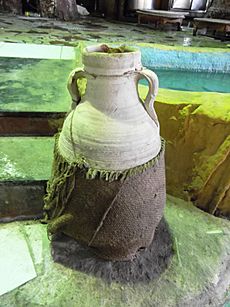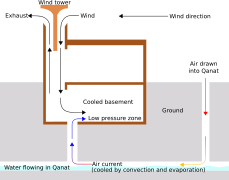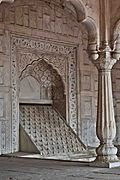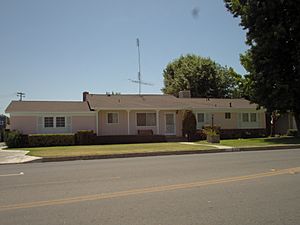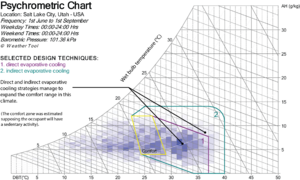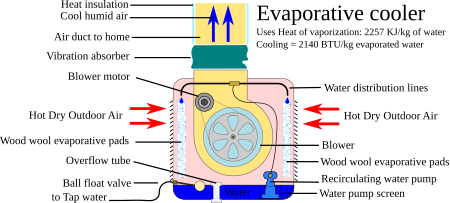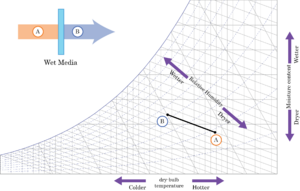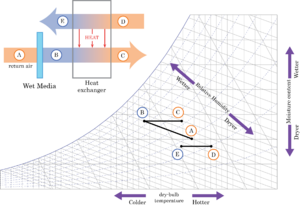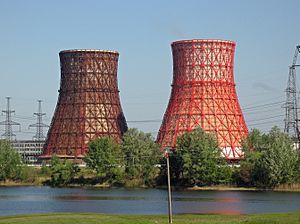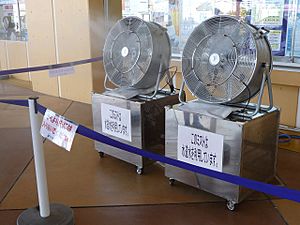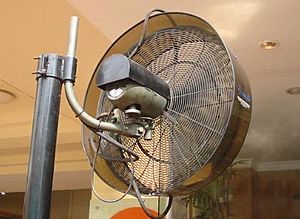Evaporative cooler facts for kids
An evaporative cooler is a machine that cools air using water. It's also called a swamp cooler or desert cooler. Unlike regular air conditioners, it doesn't use special chemicals. Instead, it uses the natural way water cools things when it evaporates.
When water turns into vapor, it takes heat from the air around it. This makes the air much cooler. Evaporative coolers use much less energy than other cooling systems. In very dry places, they also add moisture to the air. This can make people feel more comfortable.
The amount of cooling depends on how dry the air is. The drier the air, the more it can cool down. In dry climates, these coolers save a lot of energy. They are a great choice instead of regular air conditioning. Even in places that aren't super dry, special types of evaporative coolers can still cool air without adding too much humidity.
Contents
History of Evaporative Cooling
People have used evaporative cooling for thousands of years. In ancient Egypt and Persia, they used "windcatchers." These were shafts on roofs that caught the wind. The wind then blew over underground water, cooling the air. This cool air then went into the buildings. Today, many people in Iran still use electric evaporative coolers.
In the 1900s, many new designs for evaporative coolers were patented in the United States. Many of these used pads made of wood fibers to help water evaporate. A common design from 1945 included a water tank, a pump to wet the pads, and a fan. This fan pulled air through the wet pads and into the house. This design is still popular in the American Southwest. People there also use them to add humidity to the dry air. The name "swamp cooler" might come from the smell of algae that some early units produced.
Some cars used small evaporative coolers on the outside. These were popular before modern car air conditioning became common.
Old buildings in desert areas have used passive evaporative cooling for centuries. This means cooling without using machines. But Western countries only started studying and using these ideas more recently. In 1974, William H. Goettl created a "hybrid" system. It combined regular refrigeration with evaporative cooling. In 1986, researchers built a passive cooling tower. Their work helped create guidelines for designing these towers.
-
How an ancient Iranian windcatcher and qanat cooled buildings.
How Evaporative Coolers Work
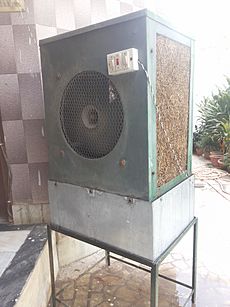
Evaporative coolers make air colder by using a process called evaporative cooling. This is different from regular air conditioners. Evaporative cooling happens when liquid water changes into a gas (vapor). This change needs energy, which it takes from the air. This makes the air temperature drop.
The energy taken from the air is called "sensible heat." This is the heat you can feel. When water evaporates, this sensible heat turns into "latent heat." Latent heat is stored in the water vapor. The total energy in the air stays the same, but it changes form. So, the air gets cooler, and it also gets more humid.
A simple example of this is when you sweat. Your body releases sweat, and when it evaporates from your skin, it cools you down. This is why you feel cooler when sweat dries. A lot of heat is removed when water evaporates. For every kilogram of water that turns into vapor, a large amount of energy is taken away. The speed of evaporation depends on how hot and humid the air is. This is why sweat doesn't dry as fast on humid days.
Regular air conditioners also use evaporation, but it happens inside a sealed system. The water vapor is then squeezed and reused. A simple evaporative cooler lets the water vapor go into the air around it. It doesn't try to get the water back.
Other Ways of Cooling
Some other cooling methods also use changes in a substance's state. For example, "sublimation cooling" is when a solid turns directly into a gas. This happens on the planetoid Pluto.
Another example is a "self-refrigerating" drink can. It has a special part inside with a powder and a liquid. When you open it, the powder mixes with the liquid and dissolves. This process absorbs heat, making the drink cold. This is similar to evaporation, but it uses a solid turning into a liquid instead of a liquid turning into a gas.
Where Evaporative Coolers Are Used
Before modern refrigerators, people used evaporative cooling for thousands of years. They used porous clay pots to cool water. Water would slowly evaporate through the pot's walls, making the water inside cooler. Old paintings from around 2500 BCE show people fanning jars of water to cool rooms. People also used two bowls, one inside the other, with a wet cloth to keep milk or butter fresh.
Evaporative cooling is a popular way to cool buildings. It's usually cheaper and uses less energy than other cooling methods.
Evaporative cooling works best when the air is dry. This is why it's very popular in dry climates. It also adds moisture to the air, which can be nice for people in deserts. They might find that the moist air helps their dry skin and sinuses.
To see if evaporative cooling will work well, experts look at local weather data. They check the temperature and humidity levels during summer. They want to know if the air is dry enough to allow good cooling. For example, in Salt Lake City, evaporative cooling works well because the air is often dry enough.
Evaporative cooling is great for places where the air is hot and humidity is low. In the United States, it's common in western states like Albuquerque, Denver, and Salt Lake City. It's also popular in the southern part of Australia. In these dry places, installing and running an evaporative cooler can be 80% cheaper than regular air conditioning. Sometimes, evaporative cooling and regular air conditioning are used together for the best results. Some evaporative coolers can even add humidity in winter.
Even in places with moderate humidity, evaporative cooling is useful. Many factories, kitchens, laundries, and greenhouses use them. They are also good for cooling specific areas like loading docks or workshops. In very humid places, evaporative cooling might not make you feel much cooler. But it still helps by moving air around.
Other Examples of Evaporative Cooling
- Trees: Trees release a lot of water vapor through their leaves. This process, called transpiration, cools the air around them. Forests help cool the climate locally and globally.
- Simple Coolers: Devices like clay pot coolers are simple and cheap. They keep vegetables fresh without needing electricity. Many hot, dry areas in the world can benefit from these. They help reduce food waste and save money.
- Cryogenics: Evaporative cooling is used to make things extremely cold. By pumping away the vapor above a super-cold liquid, the liquid keeps evaporating and cooling down. This can create temperatures close to absolute zero.
- Spacecraft: Some crewed spacecraft use evaporative cooling for short missions. They vent water vapor into space, which takes away heat. This water often comes from the fuel cells that make electricity.
How Evaporative Coolers Are Designed
Most evaporative coolers use the fact that water needs a lot of heat to turn into vapor. Because of this, they use much less energy than other air conditioning systems. However, in places that aren't very dry, a simple evaporative cooler can make the air too humid. This can make people feel uncomfortable. More advanced designs, like indirect or two-stage coolers, help keep the humidity lower.
Direct Evaporative Cooling
Direct evaporative cooling is the most common type. It lowers the air temperature and increases humidity. This happens when liquid water turns into vapor, taking heat from the air. Warm, dry air becomes cool, moist air. The humidity can go up to 70-90%. This means your sweat won't evaporate as easily, so you might not feel as cool. The moist air must be let out of the building. If it stays inside, the air gets too humid, and the cooling stops.
A typical direct evaporative cooler uses a fan to pull air through a wet pad. Water is sprayed on top of the pad to keep it soaked. Any extra water is collected and reused. These coolers are usually small. They have a pad, a water pump, and a fan. Minerals in the water can build up on the pads over time. So, they need regular cleaning to work well. Direct evaporative coolers use much less energy than regular air conditioners.
Passive direct evaporative cooling happens without a fan. This can be done with fountains or special cooling towers. A passive cooling tower lets outside air flow into the top. The air touches water inside the tower, either from a wet pad or a mister. As the water evaporates, the air gets cooler and heavier. This makes it flow down into the building. These towers are a good low-energy option for hot, dry places. They only need a pump to move water to the top.
Passive cooling towers can save a lot of energy. For example, a visitors' center in Zion National Park uses two passive cooling towers. They use 77% less cooling energy than a typical building in the western United States.
Indirect Evaporative Cooling
Indirect evaporative cooling is a different process. It uses direct evaporative cooling, but the cool air doesn't mix with the air you breathe. Instead, a heat exchanger transfers the coolness to the fresh air. The moist, cooled air from the evaporation process is released outside. This avoids making the inside of your home too humid. This type of cooling is better for homes because it keeps the humidity down.
Maisotsenko Cycle
Some indirect coolers use a special design called the Maisotsenko cycle (M-Cycle). This system uses a clever heat exchanger. It can cool air to a temperature even lower than the wet-bulb temperature. This means it can get very close to the dew point. Studies have shown that M-Cycle systems combined with regular air conditioning can be much more efficient. However, they work best in dry climates.
An M-Cycle system is used to cool a data center for NASA. It uses fresh outside air and only turns on the regular air conditioning when needed. This saves a lot of energy. These systems are very efficient, but they are still limited by how humid the air is outside.
Hybrid Designs
Two-Stage Evaporative Cooling
A "two-stage" cooler combines indirect and direct cooling. In the first stage, warm air is cooled indirectly without adding humidity. It passes through a heat exchanger that is cooled by evaporation on the outside. Then, in the second stage, this pre-cooled air goes through a wet pad. It picks up some humidity as it cools even more. Because the air was already cooled, less humidity is added in the second stage. This results in cooler air with less humidity than a simple direct cooler.
Evaporative + Regular Air Conditioning
Another "hybrid" design combines evaporative cooling with regular air conditioning. This can make the whole system more efficient. It can also cool the air to lower temperatures than evaporative cooling alone.
Evaporative + Passive Radiative Cooling
Evaporative cooling can also be combined with "passive daytime radiative cooling" and insulation. This system can cool things without using any energy, except for adding water sometimes. It uses a special material that reflects sunlight and releases heat through evaporation and radiation. This system can keep food fresh much longer, especially in dry climates.
Materials for Cooler Pads
Traditionally, cooler pads were made of wood fibers. But now, modern materials like plastics and special paper are used. These newer materials can add more moisture to the air and cool it better. They are also often thicker. Corrugated cardboard is another material sometimes used.
Important Design Points
Water Use
In dry places, water is precious. So, people worry about how much water evaporative coolers use. However, experts point out that making electricity also uses a lot of water. Since evaporative coolers use much less electricity, they often use a similar amount of water overall compared to regular air conditioners. They also cost less to run.
Shading
It's a good idea to shade your evaporative cooler from direct sunlight. If the sun heats the cooler or its pads, it will make the air hotter. This means the cooler has to work harder, and it will add more humidity to the air. Shading also helps protect the cooler's parts from sun damage.
Mechanical Parts
Besides fans, pumps are the only other moving parts in most evaporative coolers. Pumps move water to the wet pads or to mister systems. The size of the pump depends on how much water needs to evaporate.
Air Exhaust
For an evaporative cooler to work well, air must be able to leave the building. You need open windows or vents. If the air can't escape, pressure builds up, and the fan can't push enough cool air inside. The system needs a continuous flow of air. You should open windows on the downwind side of the house. This helps the hot, humid air leave the building.
Different Ways to Install Evaporative Coolers
Typical Installations
Most homes and businesses use direct evaporative coolers. These are usually metal or plastic boxes with vents. A fan pulls air through the wet pads, and a pump keeps the pads damp. The cool, moist air then goes into the building through a vent.
Since the cool air comes from outside, you need to have large vents or open windows. This lets the air move through the building and out. Air should only pass through the cooler once. If it recirculates, it will get too humid, and the cooling effect will lessen. Evaporative coolers often change the air in a room many times an hour.
Evaporative Cooling Towers
Cooling towers are big structures that cool water. They work using the same evaporation idea. But their main job is to cool water, not air. You often see them on large buildings or at industrial sites. They help remove heat from big machines or power plants.
Misting Systems
Misting systems use a high-pressure pump to push water through tiny nozzles. These nozzles create a very fine mist. The water droplets are so small that they evaporate almost instantly. This "flash evaporation" can cool the air around them a lot, sometimes by as much as 20°C (35°F) in seconds. Misting systems are used for patios, gardens, pets, and even to control insects or odors.
Misting Fans
A misting fan is like a humidifier with a fan. It blows a fine mist of water into the air. If the air isn't too humid, the water evaporates and cools the air. Misting fans are often used outdoors, especially in dry places. Small, portable misting fans are also sold, but their cooling power is usually limited.
How Well Evaporative Coolers Work
To understand how well an evaporative cooler works, you need to know about "psychrometrics." This is the study of air and its moisture. The performance of an evaporative cooler changes with outside temperature and humidity. A good home cooler should be able to lower the air temperature to within 3-4°C (5-7°F) of the "wet-bulb temperature." The wet-bulb temperature is the lowest temperature air can reach by evaporating water.
You can guess how well a cooler will work using weather reports. Weather reports usually give the "dew point" and "relative humidity." You can use these to find the wet-bulb temperature. Once you know the wet-bulb temperature, you can figure out how cool the air leaving the cooler will be.
The "saturation efficiency" tells you how close the cooled air's temperature is to the wet-bulb temperature. Most evaporative pads are 80% to 90% efficient. This means they can cool the air to 80-90% of the way towards the wet-bulb temperature.
For example, in Las Vegas, a typical summer day might be 42°C (108°F) with a wet-bulb temperature of 19°C (66°F). If a cooler is 85% efficient, the air leaving it would be about 22.45°C (72.4°F).
Evaporative coolers work best in dry places like the southwestern USA, northern Mexico, and parts of India. This is because the drier the air, the more water can evaporate, and the more cooling you get.
In very humid places, evaporative coolers are not very useful. For example, on a hot, humid day in Tokyo, the air might be 30°C (86°F) with 85% humidity. The wet-bulb temperature would be around 27.88°C (82.2°F). Even with 85% efficiency, the cooler could only get the air down to about 28.2°C (82.8°F). This isn't cool enough to be practical.
Comparing Evaporative Coolers to Other Air Conditioners
Advantages
- Cheaper to Install and Run: Evaporative coolers usually cost about half or less to install than regular central air conditioning. They also cost much less to run, sometimes 1/8 of the cost. They don't have a big power surge when you turn them on. They only use power for the fan and water pump.
- Uses Water, Not Chemicals: They use water as their cooling fluid. They don't need special chemicals that can be harmful or expensive.
- Easy to Install and Fix: Many people can install these coolers themselves, saving money. They usually only have two main parts: the fan motor and the water pump. These are cheap to fix or replace.
- Good Air Flow: They bring a lot of fresh air into the building. This means the air inside is always changing and feels fresh.
- Adds Humidity: In dry places, they add moisture to the air. This can make you feel more comfortable and reduce static electricity.
- Acts as a Filter: The wet pads can filter out dust and other things from the air.
Disadvantages
- Less Cooling Power: Most evaporative coolers can't make the air as cold as regular air conditioning. If a room is closed off from the outside, an evaporative cooler won't cool it down at all. It might even make it hotter because of the heat from its electrical parts.
- Humidity Limits Cooling: If the air is already very humid, the cooler won't be able to cool much.
- Adds Humidity: Unlike regular air conditioners that remove moisture, evaporative coolers add it. In humid climates, this can make you feel sticky and uncomfortable.
- Corrosion and Odors: High humidity can cause metal parts to rust faster. It can also bring outside smells or pollution into the building if there isn't enough filtering.
- Needs Water: Evaporative coolers need a constant supply of water.
- Mineral Buildup: Water with a lot of minerals can leave deposits on the pads. These pads need regular cleaning or replacement.
- Maintenance: Parts that can rust need regular cleaning. The pads need to be replaced often to keep the cooler working well. In cold places, you need to drain the cooler for winter to prevent freezing.
- Health Risks: If not cleaned properly, evaporative coolers can be places where mosquitoes breed. Mold and bacteria can also grow in dirty systems. This can cause health problems, especially for people with asthma or allergies.
- Fire Risk: The wood fiber pads can catch fire from small sparks.
See also
 In Spanish: Refrigeración por evaporación para niños
In Spanish: Refrigeración por evaporación para niños
- Architectural engineering
- Botijo (Spanish evaporative water cooler)
- Building engineering
- Coolgardie safe
- Cooling tower
- Dehumidifier
- Humidifier
- HVAC
- Pot-in-pot refrigerator
- Yakhchāl


